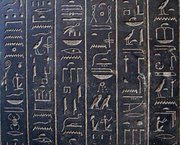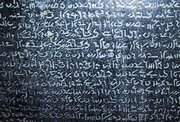
FAIR is a non-profit organization dedicated to providing well-documented answers to criticisms of the doctrine, practice, and history of The Church of Jesus Christ of Latter-day Saints.
Moroni makes it clear that "reformed Egyptian" is the name which the Nephites have given to a script based upon Egyptian characters, and modified over the course of a thousand years (See Mormon 9:32). So, it is no surprise that Egyptians or Jews have no script called "reformed Egyptian," as this was a Nephite term.
There are, however, several variant Egyptian scripts which are "reformed" or altered from their earlier form. Hugh Nibley and others have pointed out that the change from Egyptian hieroglyphics, to hieratic, to demotic is a good description of Egyptian being "reformed." By 600 BC, hieratic was used primarily for religious texts, while demotic was used for daily use.off-site
One can see how hieroglyphics developed into the more stylized hieratic, and this process continued with the demotic:

What could be a better term for this than an Egyptian script that has been "reformed"?
More recent research provides further corroboration:
The fourth presentation at BYU’s Willes Center for Book of Mormon Studies conference on 31 August 2012 was on “Writing in 7th Century BC Levant,” by Stefan Wimmer of the University of Munich. It was entitled “Palestinian Hieratic.” He examined an interesting phenomena in Hebrew inscriptions, the use of Egyptian hieratic (cursive hieroglyphic) signs.
Basically Hebrew scribes used Egyptian signs for various numerals, weights and measures. The changes in the form of these signs parallel similar chronological changes in the form of Egyptian hieratic characters, which indicates continued contact of some sort between Egyptian and Hebrew scribes, probably over several centuries. (If there had been a single scribal transmission with no ongoing contact, the changes in the Hebrew forms of hieratic signs would not parallel contemporary changes in Egyptian hieratic forms.) No other Semitic language used Egyptian hieratic signs except Hebrew (with one possible Moabite example.)
There are a couple of hundred examples of such texts, the majority dating from the late seventh century, and geographically mainly from Jerusalem southward. The phenomena ends after the Babylonian captivity. (In other words, Palestinian hieratic is most common in precisely the time and location of Lehi and Nephi, and only exists in Hebrew.)[1]
Additionally,
Documents from the kingdoms of both Israel and Judah, but not the neighboring kingdoms, of the eighth and seventh centuries contain Egyptian hieratic signs (cursive hieroglyphics) and numerals that had ceased to be used in Egypt after the tenth century (Philip J. King and Lawrence E. Stager, Life in Biblical Israel (Louisville, Kentucky: Westminster John Knox Press, 2001), 311.)
German Egyptologist Stefan Wimmer calls this script "palestinian Hieratic." See Stefan Wimmer, Palästinisches Hieratisch: Die Zahl- und Sonderzeichen in der althebräischen Schrift, Ägypten und Altes Testament 75 (Germany: Harrassowitz Wiesbaden, 2008).
William Hamblin provides additional example of such reformation of Egyptian, including:
Given that Moroni says the Nephites then modified the scripts further, "reformed Egyptian" is an elegant description of both the Old World phenomenon, and what Moroni says happened among the Nephites.




The claim that Israelites would not use Egyptian is clearly false. By the ninth to sixth centuries before Christ, Israelites used Egyptian numerals mingled with Hebrew text. The Papyrus Amherst 63 contains a text of Psalms 20:2-6 written in Aramaic (the language of Jesus) using Egyptian characters. This text was originally dated to the second century B.C., but this has since been extended to the 4th century B.C.[3]
More significant, however, was an ostracon uncovered at Arad in 1967. Dating "toward the end of the seventh century B.C.," it reflects usage from shortly before 600 B.C., the time of Lehi. The text on the ostracon is written in a combination of Egyptian hieratic and Hebrew characters, but can be read entirely as Egyptian. Of the seventeen words in the text, ten are written in [Egyptian] hieratic and seven in Hebrew. However, all the words written in Hebrew can be read as Egyptian words, while one of them, which occurs twice, has the same meaning in both Egyptian and Hebrew.19 Of the ten words written in hieratic script, four are numerals (one occurring in each line).20 One symbol, denoting a measure of capacity, occurs four times (once in each of the four lines), and the remaining Egyptian word occurs twice. Thus, while seventeen words appear on the ostracon, if one discounts the recurrence of words, only six words are written in hieratic (of which four are numerals), and six in Hebrew.[4]
Anti-Mormon authors Ankerberg and Weldon claim:
Mormonism has never explained how godly Jews [sic] of A.D. 400 allegedly knew Egyptian, nor why they would have written their sacred records entirely in the language of their pagan, idolatrous enemies" (p. 284). "How likely is it that the allegedly Jewish [sic] Nephites would have used the Egyptian language to write their sacred scriptures? Their strong antipathy to the Egyptians and their culture makes this difficult to accept. When modern Jews copy their scripture, they use Hebrew. They do not use Egyptian or Arabic, the language of their historic enemies" (pp. 294-95). "[N]o such language [as reformed Egyptian] exists and Egyptologists declare this unequivocally.[5]
They are, however, spectacularly wrong, and "Mormonism" has explained why repeatedly:
The statement "When modern Jews copy their scripture, they use Hebrew. They do not use Egyptian or Arabic, the language of their historic enemies" is quite an astonishing display of ignorance. Since the Egyptian language has been dead for centuries, it is hardly remarkable that modern Jews do not read the Bible in Egyptian. On the other hand, "the first and most important rendering [of the Old Testament] from Hebrew [into Arabic] was made by Sa'adya the Ga'on, a learned Jew who was head of the rabbinic school at Sura in Babylon (died 942)" (George A. Buttrick, ed., The Interpreter's Dictionary of the Bible [hereafter IDB], 4 vols. and supplement [Nashville: Abingdon, 1962–1976], 4:758b). Thus, Jews have indeed translated the Bible into "Arabic, the language of their historic enemies." They also have translated it into the language of their "historic enemies" the Greeks (IDB 4:750b on the Septuagint) and Aramaeans (IDB 1:185-93; 4:749-50, on the Aramaic Targums).[6]
There was a clear evolution of Egyptian script in the Old World, and these modified scripts were in use in Lehi's day. People of Lehi's time and place did use both Hebrew and Egyptian, just as Nephi claimed (See 1 Nephi 1:2).
It has been claimed that Egyptian would be too lengthy and bulky on the plates to account for the Book of Mormon:
[Egyptian would take] "perhaps four times, or even more than four times, as much room as the English, and it is quite certain that, as the Book of Mormon is 600 pages thick, it would take at least a thousand plates to hold in the Egyptian language, what is there written." (italics in original)[7]
One hears little of this critique today; linguistic "fact" has caught up with the Book of Mormon, the critics have largely abandoned this approach.
At the time that this assertion was made, knowledge of Egyptian was in its infancy. Critics of the era knew little about Egyptian, because no one knew very much. The critics were probably thinking of Egyptian hieroglyphics. However, the Book of Mormon makes it clear that reformed Egyptian had been adapted by them for concise writing. As discussed in the main article, variant Old World forms of Egyptian (such as Demotic) were quite compact, and well-suited for writing with space constraints.
FAIR links |
|
Online |
For parallels between Joseph Smith's "Anthon Transcript" characters and Egyptian writing see:
|
Video |
|
Print |
|
Navigators |
|
Sub categories |
Critical sources |
|

FAIR is a non-profit organization dedicated to providing well-documented answers to criticisms of the doctrine, practice, and history of The Church of Jesus Christ of Latter-day Saints.
We are a volunteer organization. We invite you to give back.
Donate Now